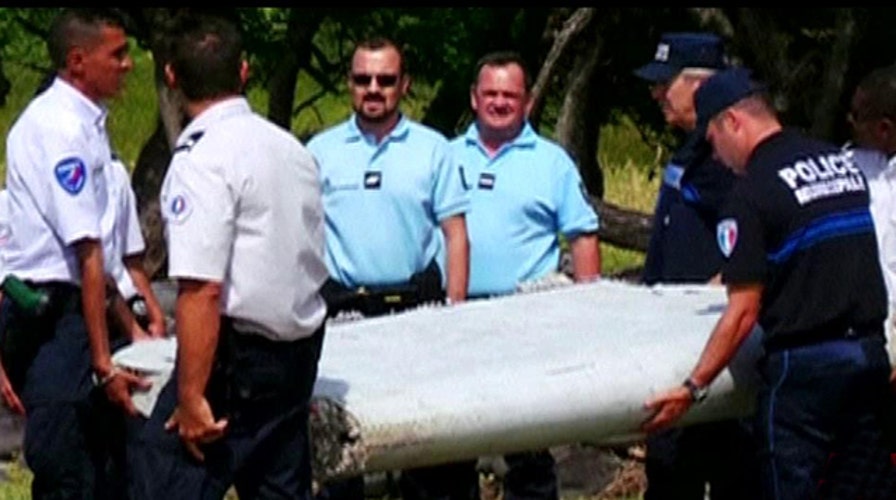Malaysia's PM confirms wing fragment is from Flight 370
Debris was discovered on Reunion Island
Malaysian Prime Minister Najib Razak said Thursday that experts in France have determined that a barnacle-encrusted airplane wing fragment found on Reunion Island belongs to Malaysia Airlines Flight 370 – the latest twist in the exhaustive search for the plane that vanished in March 2014.
Razak said at a news conference on Wednesday that "an international team of experts have conclusively confirmed that the aircraft debris found on Reunion Island is indeed MH370,” according to The Associated Press.
"We now have physical evidence that, as I announced on 24th March last year, flight MH370 tragically ended in the southern Indian Ocean," Razak added.
He also reiterated that his country’s government is committed to finding out what happened to the Boeing 777 jetliner, which veered off course during a flight from Kuala Lumpur to Beijing.
It is my hope that this confirmation, however tragic and painful, will at least bring certainty to the families and loved ones of the 239 people onboard MH370.
All 239 passengers and crew aboard the flight are presumed dead. About two-thirds of those on the plane were Chinese.
"The burden and uncertainty faced by the families during this time has been unspeakable,” Razak said. “It is my hope that this confirmation, however tragic and painful, will at least bring certainty to the families and loved ones of the 239 people onboard MH370. They have our deepest sympathy and prayers."
In a statement, Malaysia Airlines said the flaperon, part of the plane's wing, found on Reunion Island on July 29 was confirmed to be of Flight 370 by the French agency that investigates air crashes, known as the BEA, the Malaysian investigation team, a technical representative from PRC and the Australian Transportation Safety Bureau in Toulouse, France.
French and Malaysian investigators started examining the piece Wednesday. It was found by a local gardener who was searching for a stone to grind herbs, Sky News reports.
"Family members of passengers and crew have already been informed and we extend our deepest sympathies to those affected," Malaysia Airlines said.
The statement said this "is indeed a major breakthrough for us in resolving the disappearance of MH370. We expect and hope that there would be more objects to be found which would be able to help resolve this mystery."
But Deputy Paris Prosecutor Serge Mackowiak took a less conclusive approach about the origin of the debris.
Speaking at a press conference Wednesday, Mackowiak said the experts have reached a "very strong presumption" that the debris is from MH370, but the finding still needs to be confirmed.
He said experts based their findings on technical information about the plane given to them by Malaysia Airlines and Boeing.
A fragment of suitcase that was also found on the island will undergo forensic examination by French police “as soon as possible” to determine if it is from MH370, he added, according to Reuters.
Authorities believe the plane most likely crashed offshore from Australia in the east Indian Ocean. Oceanographers say it's feasible the wing fragment floated thousands of miles in a counterclockwise direction across the ocean before washing ashore on the French island.
Reunion Island, a volcanic island of 850,000 people located in the Indian Ocean near Madagascar, is roughly 2,300 miles from the area of the southern Indian Ocean where search efforts have been focused, Reuters reports.
Malaysian authorities said this week they'll seek help from territories near Reunion Island to search for more debris.
John Page, an aircraft design expert at the University of New South Wales in Australia, told The Associated Press that the heaviest parts of the plane, like the engines, would sink immediately, while other parts might get spread out by the currents before sinking, forming a triangular-shaped debris field on the ocean floor.
He said flight-control surfaces on the wings and tail would be most likely to break off and float because they are essentially carbon-fiber skins filled with air, making them strong but lightweight. They're also designed to be waterproof, so moisture doesn't enter them and freeze during flight.
Depending on how the aircraft broke up, Page said, it's possible other pieces could float. Those could include plastic and fiberglass trim, door panels, even personal belongings or luggage. He said it was unlikely any human remains would have survived very long.
The Associated Press contributed to this report.

